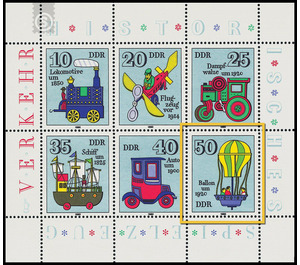Commemorative stamp series - Germany / German Democratic Republic 1980 - 50 Pfennig
Theme: Post & Philately
| Country | Germany / German Democratic Republic |
| Issue Date | 1980 |
| Face Value | 50.00 |
| Color | multi-colored blue |
| Perforation | K 14 |
| Printing Type | offset |
| Stamp Type | Postage stamp |
| Item Type | Stamp |
| Chronological Issue Number | 2313 |
| Chronological Chapter | GER-DDR |
| SID | 129143 |
| In 12 Wishlists | |
Historical Toys With the illustrations of historical toys in the field of traffic, the Ministry of Posts and Telecommunications of the German Democratic Republic issues six multicolored special postage stamps. The six postage stamps are printed together on a miniature sheet. No special First Day Covered Envelope Immediately after the invention and construction of the railroad, their small images appeared on the toy markets. The Erzgebirge toy makers made an effort to copy this large-scale model in their own way, as the ornamentally treated surface of the wooden locomotive makes clear. With the invention of sheet pressing around 1815 in France, an important condition for the industrial production of tin toys was given. Thus, especially in the second half of the 19th century, in many European countries and in the US, major companies for the production of mechanical toys made of sheet metal. The use of this material, which conformed to large-scale models, enabled greater model loyalty, better conditions for the installation of a mechanism and was accompanied by constant efforts to refine the products. As a drive for railways and other mechanical toys found the movement very early use. Later, the flywheel drive was added, which was patented in 1904 by a German company. The car initially played a modest role in the offer of the companies for tin toys, before it was able to learn after 1910 more and more popularity. From the very beginning of its production great emphasis was placed on model loyalty, so that the development of the toy car very impressively traces the history of the great prototype. However, cheap and inexpensive sheet metal items deviate from this, which were mainly manufactured between 1895 and 1914 and have become known as penny toys (groschen items). Such articles were produced in large numbers in Nuremberg. Certainly, the balloon (70 Pfennig) was a Nuremberg-made product of the period around 1920, which had come as an accessory for a steam engine on the market; Through transmission, translation and shaft this balloon could be set in motion by a running steam engine. Such accessories were mainly made in the form of carousels, pots, wells, Pochenhämmern and saws. It should enrich the game with the steam engine through movement and acoustic effects. The selection of historical toys presented here highlights the value that this commodity, so important to the child's development, has as well as a cultural-historical document, as it bears witness to the creative abilities of its producers as well as to the efforts of society in the play of the child ,


